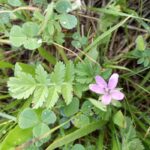Ερωδιός ο μοσχάτος
Etymology of Erodium moschatum: The name of the genus, "Erodium", derives from the Ancient Greek "ἐρωδιός" [erodios], meaning "heron", due to the long beak on the fruit that gives rise to some of its common names such as storksbill and cranesbill, a meaning reinforced by the family name Geranium, the derivation of which is "γερανός" [yeranos or geranos], meaning "crane". Neutral epithet "moschatum" derives from the neutral Ancient Greek "μοσχάτον" [moschaton], meaning "pleasantly smelling, fragrant, aromatic".
At least nine Erodium species and subspecies/kinds have been recognized in Cypriot nature so far.
Erodium moschatum is a common plant in Cyprus. It is an annual or biennial plant reaching up to 50 cm tall. Erodium moschatum exists all-around Cyprus, except for the Central Mesaoria region, at an altitude of up to 1375 metres. It is a plant found in cultivated or uncultivated areas and along roadsides. Erodium moschatum usually blooms between December and May.
How to identify Erodium moschatum:
Erodium moschatum's leaves are quite similar to the ones of Erodium cicutarium subsp. cicutarium, but if you check carefully you will see that its leaflets are often lobed but not deeply pinnatisect as the ones of cicutarium.




